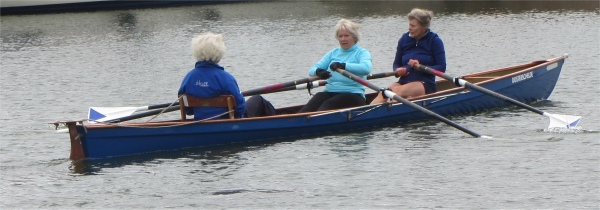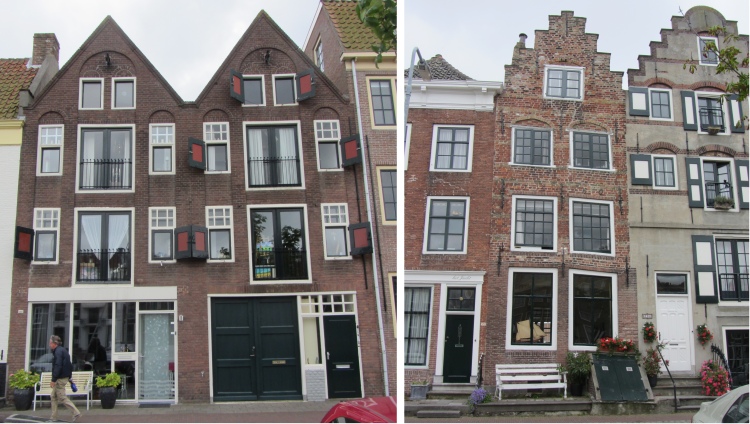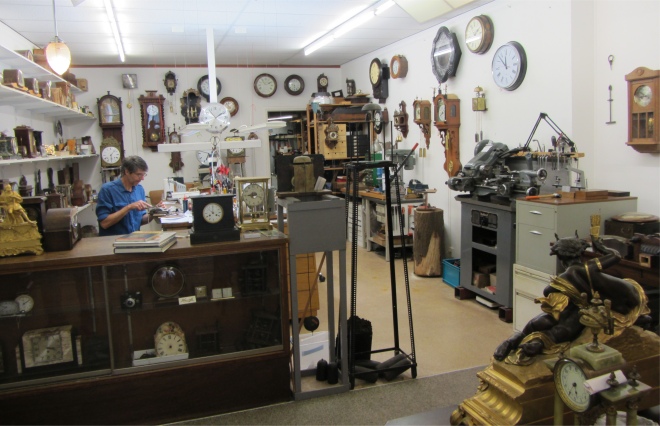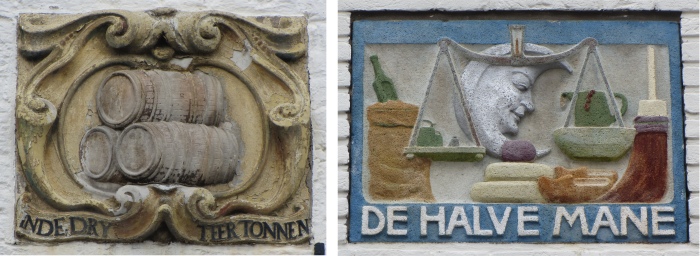Our next obvious port of call at the heart of the city was the Abdij, Middelburg Abbey (Abbey of Our Lady). In 1127 Norbertine came to Middelburg. These monks were followers of Norbert of Xanten. They established here the Premonstratensian from St. Michael's Abbey in Antwerp. In 1401 the abbey came under the influence of the Pope. One of the abbots was Nicolaas van der Burch (Nicholas de Castro), who in 1559 was appointed as the first bishop of the newly created diocese of Middelburg. The monastic life came an end in 1574 after the long siege of Middelburg (1572-1574), which ultimately resulted in the capitulation of the Spanish-minded Catholic city. Despite assurances from William of Orange that clerics should not be harmed, the abbey and the Catholic faith in it were terminated forcibly. The abbey was then occupied by the regional government and had since been the provincial administrative centre of Zeeland. Initially, the abbey served as the seat of the States of Zeeland and the Delegated Councils and some related administrative bodies, such as the Admiralty of Zeeland, and it also housed other regional institutions such as the Mint and the Court. Since 1812, the Provincial Government of Zeeland had been located there, and the complex was also known as the County Hall. The complex had been restored several times, most recently after the destruction by fire as a result of the bombardment of Middelburg on 17 May 1940 . Until the end of the 20th century, it housed several government services, such as the Land Registry and the National Archives in Zeeland.

Nieuwe Kerk
|
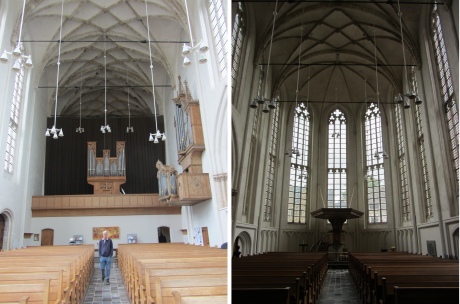
Koorkerk
|
For four centuries (until 1570) the monks worked on their Norbertine abbey. They expanded the complex into what it was today: churches, religious spaces, cloisters, stair towers and vaults. It was like a ring of impressive architecture around the central Abdijplein (Abbey Square). The whole was crowned by the 91m tall abbey tower, "Lange Jan" (Tall John), regarded by many as the ultimate symbol of Middelburg. Three churches were contained in a cluster in the complex: the 14th-century Koorkerk (Choir Church), the 16th-century Nieuwe kerk (New Church) with a famous 16th century organ, and the 17th-century Wandelkerk which held the tombs of Jan and Cornelis Evertsen, admirals and brothers killed fighting the English in 1666. The northern section housed the Zeeuws Museum, renovated in 2007 by a well-known Belgian architect. The museum had fine collections of china, silver and paintings, and tapestries. The vast inner courtyard, the Abdijplein, behind the churches was immaculate, as to be expected in the Netherlands, and echoed of history. Tall trees stood proudly waving in the breeze, and ancient gates led out into the old city.

Cloister Ceiling
|
We spent some time wandering around the churches, marvelling at the well-defined lines of the buildings, the simple colour schemes, and the plain glass windows. Huge ornate organs hugged the walls, and I wondered how their sounds must have echoed around the spacious shells which enclosed them.

Lange Jan
|
A quadrangle of cloisters was attached to the churches, time for a quiet stroll far from the maddening crowd inside the churches. The vaulted ceilings, made entirely of bricks, really impressed me. All those centuries ago craftsmen must have toiled for an age building these. A series of display boards stood inside one arm of the cloisters, giving an account of Dutch involvement in the slave trade. Sadly all the literature was in Dutch. The display rang a chord with posters I had seen elsewhere in the city, and I learned that a series of talks were being given throughout the city over the month covering that shameful aspect of the Netherlands history.
Slave trading was carried out in the West coast or Gold Coast of Africa, now Ghana, and the slaves were shipped to Suriname, the Dutch Antilles and Aruba. The ports of Vlissingen and Middleburg in the south-western State of Zeeland became dependent on the slave trade to an unparalleled degree, beating even Amsterdam as the main departure point for slavers. Ships from Zeeland made 672 journeys to Africa, transporting 278,476 people into a life of slavery, compared to the 173 recorded voyages from Amsterdam, carrying 73,476. The two ports were practically slaving communities, and official reports indicated that by 1750 the only significant commercial activity in Vlissingen was the slave trade. This marked quite a transformation for the province, which in 1596 had steadfastly rejected the opening of a slave market in Middleburg, on the basis that Dutch law did not countenance slavery. The momentum that drove slavery brought on a transformation in attitudes within the area, and saw Middleburg become host to the largest independent slaving company in the Netherlands. The Middleburg Commercial Company (MCC) transported 31,095 Africans to the Americas between 1732 and 1803, of whom 27,344 survived the crossing.

Cloister Herb Garden
|
In the centre of the quadrangle lay the Kloostertuin (cloister garden). During the early nineties, some Middelburg gardeners took the initiative to create the garden, which was inspired by the herb garden at the Utrecht Dom, and the delightful herb garden before me was opened to the public in November 1995. The garden comprised "pockets" lined by box trees, containing medicinal herbs, aromatic herbs, spices and native plants, basically plants that were already known in the Middle Ages. I recognised some of the herbs, Rex, being a keen gardener, recognised many. However, he considered some of the plants as more flowers than herbs. I was in no position to argue.
As we were leaving, I stopped at the information desk to ask a question about one of the churches. The chap on the desk immediately started giving me a detailed account of all three of them. He didn't stop there ..... We learned that he had lived in North London, Canada and umpteen other places, and not only did he speak the various languages, but he could also turn on the regional accents too. He was a joke a minute, and he also threw in for good measure an up-to-the-minute account of the Football World Cup. We left him chuckling and extracted ourselves out.
I had read that on the north side of Middelburg, on Molenwater, Miniatuur Walcheren stood, a large model of Walcheren, showing the island's historic buildings and other features (200 buildings in all) in appropriate settings. Even the Veerse Meer was meant to be represented, with boats operated by remote control. The model was originally made in 1954 by hundreds of local people for an exhibition on the reconstruction of the island. So, I dragged the long suffering Rex up to see this marvel, poor lad. We entered the large set of gardens, passing two old ladies on deckchairs who had their art pads balanced on their knees as they painted an obscure, dilapidated bandstand. Or were they there just for a chinwag? Things went downhill from there. The gardens were in a seriously neglected state, and the models were in an unrecognisable state of disrepair, though we could make out what must have represented canals at one time or other. Odd modern day sculptures were interspersed across the gardens, but these too had seen better days. But despite all of the depressing sights surrounding us, a few brave colourful flowers poked their heads above the parapets, a reminder that life will always struggle and win through. As we left, an old man turned up on his bike, complete with easel and art materials, presumably to join the two old dears. At the fag end of life, why did they have to congregate in such a sad place, when there are delightful, joyous places elsewhere in the city?
[ I have since learned that all the miniature models had been removed and relocated to Pretpark "Mini Mundi", at Podium, a children's entertainment park about 2 km south of Middelburg Station. All that remained at the original site were concrete plinths where the miniature buildings used to be, although the area was freely accessible,and the signs were that it might be developed as a public park. ]
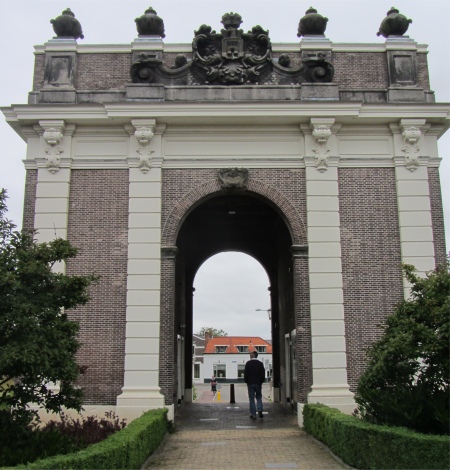
Koepoort
|
Quite close to the "Garden of Decay" we had just left, next to the theatre, stood Koepoort (cow gate). In olden times Middelburg possessed eight city gates, part of the Middelburg fortifications. Today, only Koepoort, a detached gate from 1735, had been preserved in its entirety. Its designer was the Italian engineer in the Spanish service, Donato Boni Pellezuoli. He also designed fortifications in Utrecht, Antwerp, Fort Rammekens in Ritthem (municipality Vlissingen) and the Imperial stronghold on the Vlissingense boulevard. Inside the arch, a couple of old unadorned doors provided access to the interior of the monument. Apparently, an artist, Van der Pool, lived and worked in the Koepoort. Van der Pool also had studios in Paris and New York. Abroad, he was known as a painter of historical architecture. Ideal place to live then.
Time was moving on, we had to draw our whistle-stop tour to a halt and head back to the good ship
Duonita, picking up milk and bread on the way. Chores needed to be carried out before Meryl arrived. Meryl gets no pleasure whatsoever in sailing long distances over sea, particularly the North Sea, and she certainly would not have enjoyed the crossing we had experienced. She had opted to catch a ferry across from Harwich to the Hook of Holland, and then catch trains to bring her down to Middelburg. Rex had learned that she had caught the 9am ferry, and she calculated from train timetables on the web what time she would arrive at Middelburg station.
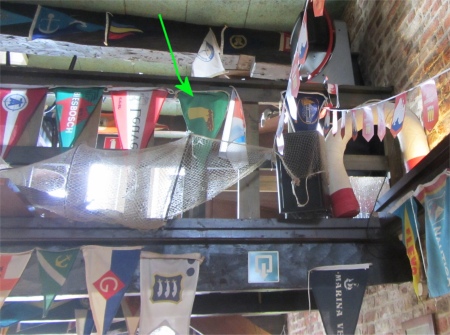
MudClub Burgee
|
We both went to the train station to meet and greet her, leaving well in advance of her arrival. Spinning out a coffee at the station, Rex received a text message from her that she would be an hour late, and she insisted that we go and enjoy a beer while we waited. How very kind of her, and of course regrettably we were duty bound to follow her instructions to the letter. So there we were, back at the marina club house where we partook in a glass of the amber nectar. We got into the spirit of things with the locals watching Belgium play Algeria in the World Cup. It was then that Rex spotted and proudly pointed out the MudClub burgee hanging up in the clubhouse. Several years earlier, when a group of the MudClubbers stayed in the marina, Rex had been tasked with presenting the burgee to the clubhouse as a token of goodwill. He was over the moon that it had not been casually discarded, and had it taken its place amongst the hundreds of other burgees from clubs from all around the world.
At last Meryl arrived, and after fond exchanges we retired to a nearby bistro for sustenance. We entered a large square room. Several couples were sat eating and drinking, all occupying tables along the back wall of the bistro. They were all sitting in silence, their mouths slowing chewing over food, or in half gulped drink poses, staring at an animated screen in the corner. Yes, they were all watching a World Cup game, it could have been the same one we had been watching in the clubhouse. "Where do you want to sit?" asked a young waitress who had sidled up to us. "At a table," I replied. She took the remark in good fun. Soon we were enjoying an excellent meal and catching up on gossip.
It had been a long day for Meryl, so in short order it was: return to the boat, discuss immediate plans, nightcaps and sleep.
